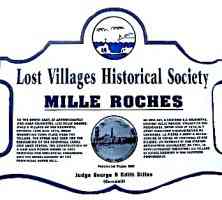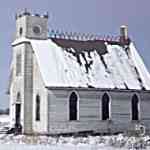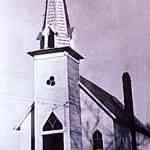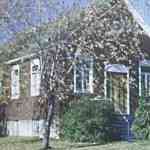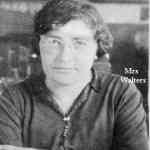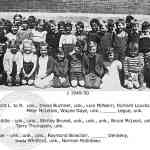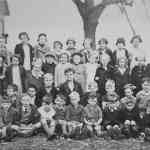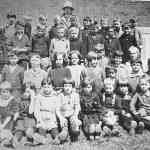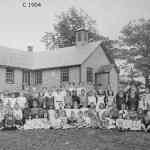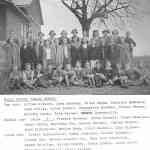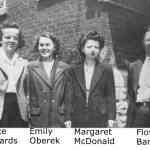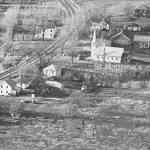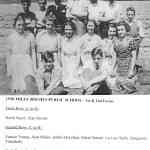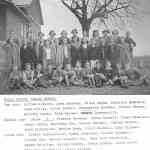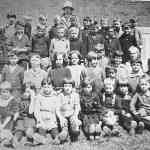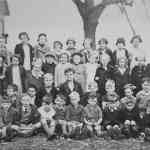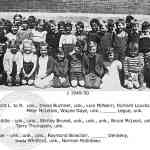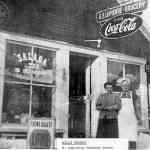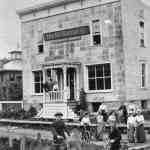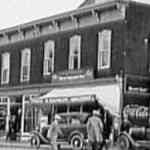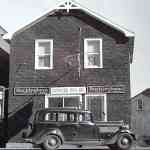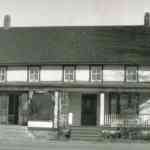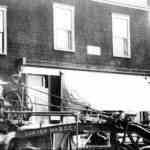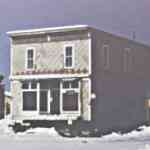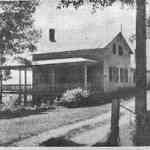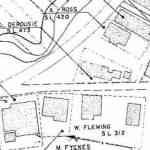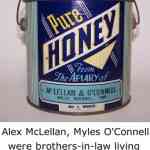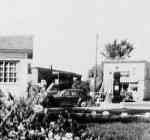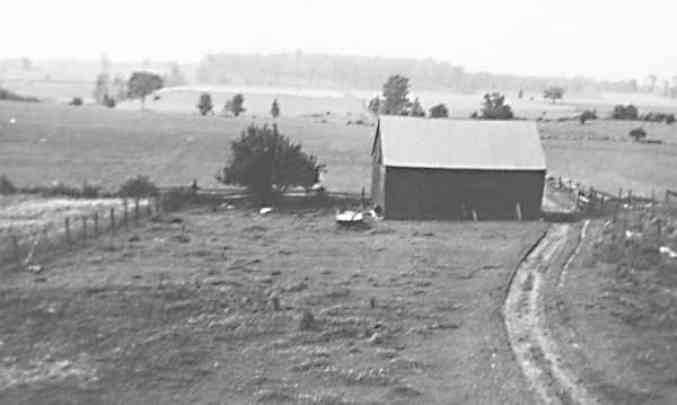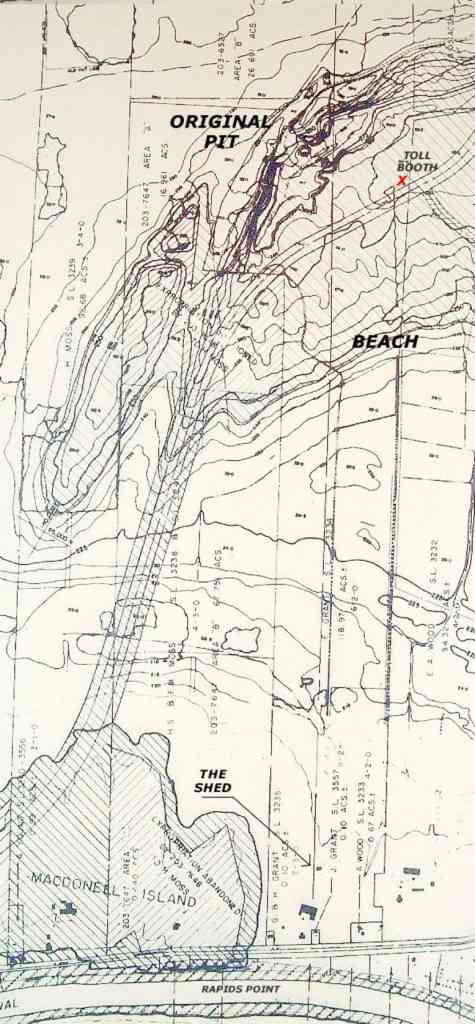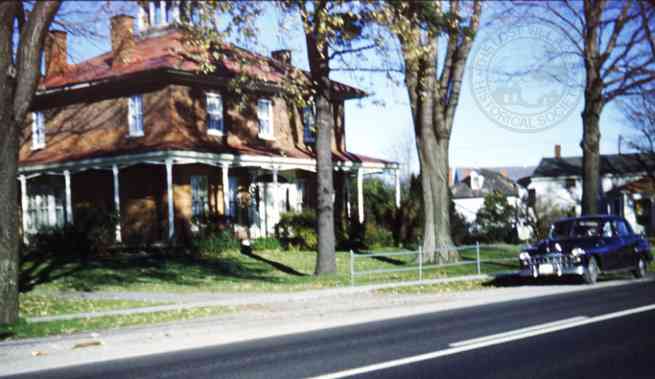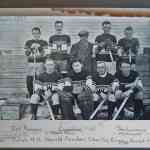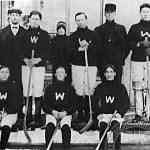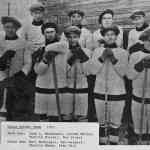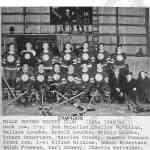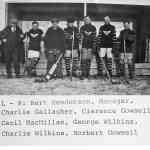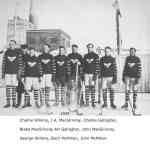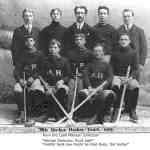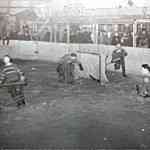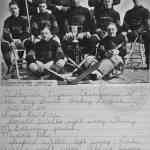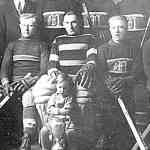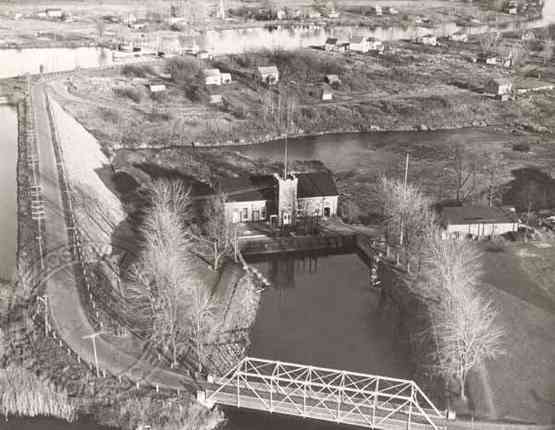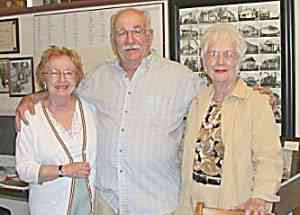Mille Roches
The village of Mille Roches lay 8 kilometers west of Cornwall and “Old Mille Roches” and “New Mille Roches” were separated by a canal, until July 1, 1958. It was developed on lots 26 and 27, in the Township of Cornwall, (Royal Township #2). The name Mille Roches, (meaning Thousand Rocks in French) referred to the rocky deposits of the Long Sault Rapids, or to the large limestone quarries to the north of the village. Because the Governor of New France was seeking permission from the King of France to extract the rock at this site in the early 1700’s, it is believed that the reference to the quarries is the most accurate translation. The true meaning may never be known.
By the 1830s, Mille Roches was showing definite signs of growth. The village was in the enviable position of having convenient access to a substantial amount of waterpower and within a short period of time, mills began popping up everywhere. Before long the village boasted an “extensive” grist mill, a marble factory and cutting mill, a carding mill and clothing works. A post office opened in August 1835. However amidst all the bustle, optimism and prosperity, a dark cloud was looming on the horizon. Events were beginning to unfold that would cause the citizens of Mille Roches serious anguish and come close to annihilating their promising little community.
Construction of the Cornwall Canal began in 1834. The 18 kilometer long canal, which started at Cornwall harbour and traveled westward through Mille Roches and Moulinette to just east of Dickinson’s Landing, would finally allow safe passage around the Long Sault Rapids. However the canal intersected across the main road both north and south of the village virtually cutting it off from surrounding communities and making winter travel completely impossible. To make matters worse, the construction crew at the quarry turned out to be much larger than originally planned and they were rapidly consuming all the wood, leaving very little fuel for Mille Roches’ homes and businesses.
As business prospects dwindled and the fuel supply tightened, the villagers understandably became furious. They started by pleading their case with the commissioners, demanding bridges and restitution for lost income and property value. They got nowhere. Finally, 35 villagers led by George Robertson, a respected mill owner, took their case to the legislature and secured a partial victory of sorts. The petitioners received restitution, but no bridges.
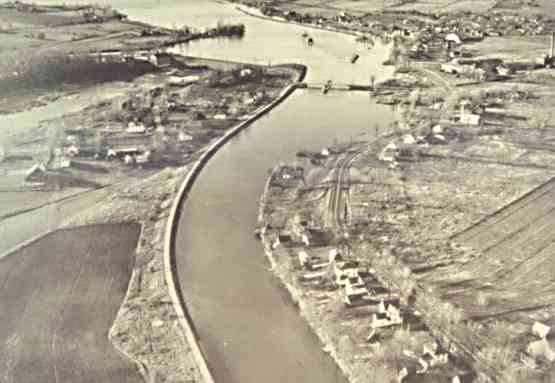
By the mid 1840s, Mille Roches was on a definite slide downwards as a result of the canal debacle. The situation was becoming so critical that Smith’s 1846 Canadian Gazetteer’s description of the community read “it was once flourishing”. Although its black limestone was still highly prized and the village continued to support several mills and a couple of stores, its future prospects looked pretty bleak. Gradually the community shifted northward and the cut-off piece became known as Old Mille Roches. Things began to turn around after the railway arrived in the mid 1850s
The railway threw Mille Roches a new lifeline and it didn’t take long for the community to find itself back in business and growing rapidly. The village boasted a wide range of services along with a large number of tradespeople and artisans including three cabinet makers, a couple of wheelwrights, two blacksmiths and a tannery. Some like Louis Derousie, who was a shoemaker, blacksmith and innkeeper, wore several hats. Simon Ault owned both carding and fulling mills along with a cloth factory. Other mill owners included George Robertson, who owned grist and oat mills and David Tait, who owned a sawmill, Israel Brooks, a cabinet makers, built the Brooks Furniture Company, highly regarded for its fine products. There were two butchers and three general stores, including a huge one run by American born Whitcomb Kezar. The Kezars also ran the post office from 1885 until 1923. The Kezar home, with its wraparound verandah and cupola on the roof, was among the finest in the area.
The Kezars were not content to sit tight with their large general store. By the late 1800s they were acting as agents for The G. E. Harvey Co., Manufacturing and Chemists, who manufactured pharmaceuticals, a large range of other medical products such as plasters, bandages and syringes, as well as cheese factory supplies. Kezar and Bennett later became known as Bennett & Messecar Co. Ltd. Other businesses included the Carpenter brothers, General Merchants.
With businesses rapidly expanding and the difficulties of the Cornwall Canal far behind them, the citizens of Mille Roches were well prepared to take on the challenges of the twentieth century.
The village thrived between 1890 and 1910. It was at this time that the canals and locks were being rebuilt in the community and a power house was constructed in conjunction with the creation of Bergin Lake. This headpond had been created by damming the north channel of the river and enlarging the St. Lawrence between the mainland and Sheek’s Island and from Mille Roches to the western end of Sheek’s Island and/or just beyond Sand Bay. Rock from the nearby quarries was hauled to the waterfront and used in canal and lock construction. This work allowed for larger boats (canallers) to negotiate the Long Sault Rapid section of the St. Lawrence River. The powerhouse was completed in 1901 and created 3000 horsepower and along with the canal reconstruction helped to establish an industrial base in the community. The Provincial Paper Mill itself provided employment to over 300 workers. This mill with some of its machinery and workers was relocated to Thorold, Ontario, some other pieces of equipment were shipped to India.
Mille Roches was a typical community of the time with Mille Roches Public School, St. George’s Roman Catholic Chapel, Mille Roches United Church and Emmanuel Pentecostal Church being prominent buildings in the community. As well Mille Roches boasted a large arena with its high arched roof and natural ice surface. The Grand Trunk Canadian National Railway station was at the north end of the community and the Moccasin was a locomotive which was well-known to the village residents. In order to complete their high school education many students at that time had to travel to and from Cornwall on the Moccasin. A business core developed along Mille Roches’ main street and Highway#2 which followed the riverbank and the shoreline of Bergin Lake.
The Freeholder, Cornwall, ON – May 17, 1923
Recently the population of this village has been taken and it is now 651. There are 366 people south of the railroad track and 285 north of it. Recently, a petition signed by the citizens of Mille Roches was sent to the Canadian National Railways, and the Township Council, to have a subway built under the railroad at the crossing here. The company has sent a man to investigate the matter and to keep account of the traffic over this road. It is surprising to know that on Monday, May 14, there were 765 people on foot and in buggies and 58 in automobiles, who crossed the track. Nineteen railroad trains passed the village that day.
At the time of inundation, July 1, 1958, many homes and inhabitants from this community were moved to New Town #2, later to be named Long Sault. Today the village name is recognized with Mille Roches Road being the most easterly street in the community and Mille Roches Island with it’s Mille Roches beach being situated on the Long Sault Parkway, directly opposite to the mainland at Long Sault.
THE LOYALIST SETTLERS at MILLE ROCHES
William Claws (Clause) was born in America in 1765, enlisted with the KRRNY on November 13, 1781, and was ranked as an ensign. He was promoted to Lieutenant on August 24, 1783 and was the eighth senior lieutenant in the regiment until its disbandment in 1783. He originally settled in Montreal in 1784, but by 1786 had settled in Royal Township #2.
Abraham Marsh was born circa 1750 and died at Mille Roches, Cornwall Township, on May 8, 1833. He married Catherine French, daughter of Jeremiah French of Maple Grove. On the April 3, 1790 Muster Roll for Cornwall and Osnabruck, Abraham Marsh is listed in Captain Jeremiah French’s Company. He was formerly of the 84th Regiment (Royal Highland Emigrants). Abraham Marsh was buried in Maple Grove Cemetery and his remains and gravestone were moved to the new Maple Grove Cemetery, (Vincent Massey Drive, Cornwall) prior to the inundation of July 1, 1958.
HISTORIES OF BUSINESSES & PLACES IN MILLE ROCHES
CHURCHES of MILLE ROCHES
PUBLIC SCHOOL
STORES
The Carpenter Brothers – General Merchants
Everett Bush’s Snack Bar & Taxi
Blacksmith Noah Cutler
L. Allinotte’s Plumbing & Heating
Alkerton’s B/A Service Station
GRAVEL PIT
Grant Gravel Pit – now the site of Mille Roches Beach
Well that’s not entirely correct. This is how this photo was labeled but the actual gravel pit is behind the forest on the hill in the background. There are still some remains of the pit along the north shore of Mille Roches island, just west of the present day toboggan hill. Most of the forest can still be seen there today. The present day Mille Roches beach would be in front of the forest in the photo.
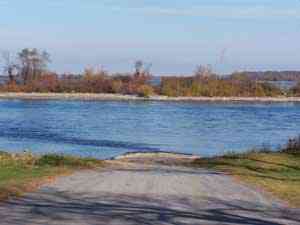 The photographer was on the north side of highway #2 looking northwest, just east of Rapids Point and just east of where the highway now dips into the water today.
The photographer was on the north side of highway #2 looking northwest, just east of Rapids Point and just east of where the highway now dips into the water today.
The photo at right is looking east at Royal Baker island, it’s the small island off the eastern tip of MacDonell island. As the year go by it’s getting more and more difficult to see the remaining piece of highway as it’s getting overgrown. The entrance to the Grant farm is submerged between these two sections of road.
The drawing below is of a survey done prior to construction and shows most of the buildings, farms and owners with a rough estimate of where the new dry land will be, in this case MacDonell island and causeway in the Long Sault Parkway.
This drawing shows the buildings on the farm of G & H Grant and judging from the elevation the picture may have been taken from “up in” the barn. This drawing confirms that there is a small building north behind the barn. Click on the drawing above for a large version showing the entire farm.
MILLE ROCHES STREET NAMES
KINGS HIGHWAY #2
AVENUES
MAPLE
LILLIE
PAULINE
STREETS
EARL
CARLING
MAIN
RICHMOND
FARIVIEW
WILLIAM
KEZAR HOUSE
SATURDAY, JULY 14, 1956
DAILY STANDARD FREEHOLDER
Old Mille Roches Home Filled With Nostalgia
By RAY DEXTRAS
Ever since work began on the St. Lawrence Power and Seaway development, the people of this area have, en masse, literally “opened their eyes” to the treasures of local history stored away in attics, cellars, closets, artistic and antique fireplaces, woodwork, furniture, papers and just as important, the house themselves.
The grand, old houses of this area have attracted the attention of many observant and interested people, including a recent investigation and research program carried out by architectural students form the School of Architecture, University of Toronto. An Ontario College of Art teacher is presently writing a thesis for her Master’s degree for the University of Illinois and she is using local and district house for subject material.
One of these precious treasures of local history is the Keezer house at Mille Roches. Standing handsomely on a square stretch of green, amidst shrubberies, plots of red roses, lilies of the valley, irises, flocks, and peonies, the nine room mansion is the picture of gay society life of 100 years ago.
The curving sidewalk leading up to the arched entrance is cracked with wear from generations of anxious and happy feet, hurrying up to the house which seems to emit a promise of comfort and luxury, in an elegant manner. (only the houses that have been lived in for a long time seem to absorb the collective or predominant atmospheres of the succeeding families that have occupied them). The atmosphere in the Keezer House (now occupied by Miss Lera Fyckes) is one of graceful, dignified living; happiness, with maybe just a tinge of tragedy, ironically enough, the house will be torn down with the flooding of the Seaway.
Miss Ruth Home, head of the museum department at the Ontario College of Art, while visiting the Keezer House for research purposes, not long ago remarked as she was leaving: “It’s fascinating, I can almost see laughing women gliding down the stairs in colourful hoop skirts. Which goes to prove that the house affects you that way.
ANOTHER WORLD
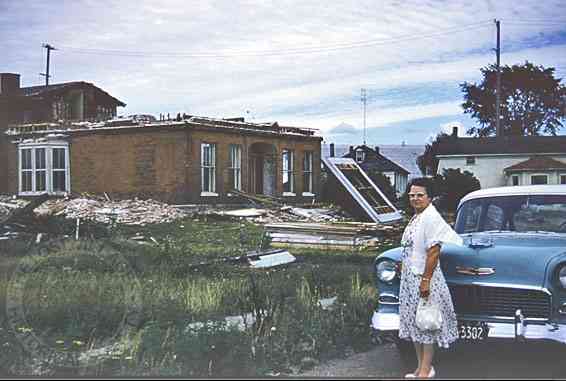 Climbing up the front stairs, you pass between two slender columns of the piazza, then through arched doors, surrounded with coloured glass in hues of red, blue, yellow, and green. As soon as you enter the house, it feels as though you are stepping into another world; it’s not a frightening sensation, but more like what a poet must feel when he sees something beautiful and inspiring.
Climbing up the front stairs, you pass between two slender columns of the piazza, then through arched doors, surrounded with coloured glass in hues of red, blue, yellow, and green. As soon as you enter the house, it feels as though you are stepping into another world; it’s not a frightening sensation, but more like what a poet must feel when he sees something beautiful and inspiring.
At late forenoon, the entrance hall was dark, except for the sun shinning through the coloured glass. Blue, green, yellow, and red sunrays played on the dark wood of the staircase (the one Miss Home mentioned) the marble coloured stairs, and reflected off the chandelier up to the high white ceiling.
The your technicolour introduction into a pleasant world. You proceed to your left and enter the parlour, and the first thing that strikes you is the fireplace, solid marble. The Brilliant highlights on the stone are caused by sunshine pouring in through the floor length window at your left. Another brilliancy attracts your attention to the right: great white French doors leading in to the library. The piano against the wall is not just a decoration, Miss Fyckes teaches the instrument to Mille Roches children.
The library is small and more of a den, cozy and comfortable. What thoughts filled this room for over 100 years, the changing ideas, possibly amazing but forgotten fore thoughts? In a house like this, one can’t help but feel that great things have happened here.
Upstairs, we arrive at a large wide landing, the high walls and ceiling of the long hall resounding with the “tock tock” of an old fashioned clock. In each of the five spacious bedrooms stands the inevitable large, extremely comfortable looking and inviting bed, with the slim brass work at head and foot.
Up another flight of stairs we go to a much smaller landing and a door leading into the attic. Beside the door stand some slabs of board, and on one is the faint outline of the carpenter’s sketch for lathe work, probably the design for the columns of the piazza. Speaking of the piazza, it covers three sides of the house, the front, east and west walls, a simmer porch and shed extending at the back from the north wall. There was probably many a Sunday afternoon promenade along that wide broad walk and about the spacious lawn.
SPORTS
AERIAL VIEW
Mille Roches Native Returns Home
Marian Kirkbride has spent 51 years in the United States, yet has remained a Canadian citizen and says this is not about to change. Born Marian L. Rafuse, in Halifax, Nova Scotia, she is the elder sister of our Society member Alan Rafuse. Marian is a Professional Educational Therapist in Santa Fe, New Mexico. She visited the village recently and we had an opportunity to catch up on what she has been up to since she left Mille Roches.
The Rafuse family moved to Mille Roches in 1934. Marian has three brothers: Alan, Richard and Nelson, and one sister, Patricia. Marian treasures the memories of her time there…the village school that housed ten grades … her friends, Shirley Sheets and Frances Markell … the little yellow house where her family lived on the bridge road across from Sheik Island … the hundreds of trips up to the village to Derosiers store:
I dream about it and I dream about it all the time…it is so incredible! I’m walking along and I’m passing the paper mill and then passing Robertson’s house sort of on a corner… and then there’s a slow kind of grade up and I remember Floyd Barkley lived at the top of that hill. I spent a lot of time at the little United Church there with Mr. Dawes – Charlie Dawes – and the little building across the street where I went to Sunday School. I remember walking by Clarence Stancel’s house – he was an executive with the paper mill – Lera Fickes’ house … and I remember right in the middle of the village where you could go up and across the railroad track … I dream about that and I’m always going to catch that train and I’m always late. I miss the train.
The Rev. Charlie Dawes had a very deep influence on Marian’s life:
He was a male influence and a spiritual influence. I think I can say that he was the very first intellectual I ever knew. I never thought of my teachers as being intellectuals. He was British and he could talk about books and things like that. I was a member of the C.G.I.T group and we’d go around singing. I can’t stay on a note if someone holds a gun on me but I was out there singing. We’d go around to the churches in the fall when they were having their harvest dinners. Rev. Dawes was very musical. He could play piano with his long incredible fingers dancing over the keys. When I was in teacher- training in the Ottawa Normal School, I was President of the Literary Society and responsible for creative programs for the student body, and I invited him to come, and he came and talked about music.
Floyd Barkley, as well, played an important part in Marian’s school life:
Marian attended high school at Cornwall Collegiate Institute(C.C.I) which later became Cornwall Collegiate and Vocational School (C.C.V.S). She remembers carrying her “little green lunch pail” and riding in the local bread truck – a panel truck – into C.C.V.S and being teased by the Cornwall students. They’d taunt her and the other young passengers by saying, “Here comes the stale bread from Mille Roches!” Still, Marian loved high school. She graduated from C.C.I and began teaching in 1945:
As a young teacher I graduated under special conditions. Those of us in the top five percent of the graduating class were allowed to attend Normal School for just one year so I had only one year of training and then out in the classroom. There was a great shortage of male teachers at that time because it was wartime in 1945. So when I started teaching, I wasn’t yet 18 years old. We had to sign up for two summer sessions and were obligated to teach for five years before getting our permanent certification. A teacher, Miss Maginnis, had an influence on me as well. I had wanted to be a French and Latin teacher. I was her star pupil,
Marian’s year at Normal School was her first time away from home and she wasn’t used to city life. Catching a bus was a challenge to a sixteen year old from the country:
The bus would stop at a corner and people would get on. I’d stand at a corner and the bus wouldn’t stop for me so I had to figure out there must be something about their corner. So I walked to that corner and sure enough there was a little sign that read Bus Stop. That’s how naive I was.
When the war ended, it was a scary day because of the absolute mobs of people out in the streets and the guys were grabbing the girls and there was chaos everywhere. Marian walked home from downtown Ottawa through the back streets to avoid the intimidating crowds.
One of Marian’s training sessions during her year of Normal School was in the village of Wales. The teacher was Mary Snyder. That winter the snowbanks were so deep that the tracks they made for Marian to walk in were almost too deep for her to follow, being the little person that she is. Her first position was teaching grade one at Maxville, then to Belleville and on to Niagara Falls where she met her first husband Bradley Currey. They had three children. Lee, the eldest son, lives in Seattle. Jefferson, who was born in Canada, resides in Boise, Idaho, and Elaine lives in Tuscon, Arizona. Marian has 6 grandchildren and 6 great grandchildren.
Marian moved to Santa Fe, New Mexico, five years ago from California where she lived for over 30 years. She considers Santa Fe as one of the great cultural cities of the United States, a combination of Pueblo Indian, Hispanic and Anglo cultures all still living together, intermingling yet separately, and I like an historical place like that with something always going on. I like challenges. I’m pushing the envelope all the time. I love to study and Santa Fe is packed with history. This wee teacher with big orange hair – as one pupil has described her – finds time to pursue another interest – photography. New Mexico, she says, is a dramatic place with an elevation of 7500 feet. The impressive mountains and starkness of the desert, and the sunsets, the adobe buildings …and no smog… are all picturesque both cultural and historical, and so exciting to photograph. Marian has worked forty years with special children, and is a pioneer in the field of Educational Therapy working with dyslexic children and adults. She has even taught workshops for the University of California at Santa Barbara.
What does the future hold for Marian (Rafuse) Kirkbride?
The future for me is achieving a dream of many years by making this trip. I call it my Canada Wall to Wall trip. I flew to Vancouver, caught the train to Toronto… three days and three nights…wanted to see my country. My sister and I have rented a car and we’ll do the rest of the trip to the east coast by car and train and right back to my birthplace, Halifax. The rest of my dream is to finish my memoirs.
Marian has a book in the making. She is co-writing her memoirs called The Little Teacher That Could. Sixty-three years of making a difference in the lives of others, she has done it without a PHD. Still working out of her home, 10 hours a week, with dyslexic children, she muses, I can’t get away from it. The little kids keep falling out of a tree on me. Marian is 80 years old in September. One would never think it of this tiny, red-haired bombshell. The conversation with Marian was stimulating. We can only guess how much better her memoirs will be.
Marian is interested in hearing from old school chums. You may contact her at:
TRIBUTE TO GEORGE A. DEROUSIE
BY L.T. WELCH
When visiting the Lost Villages Historical Society Museum at Ault Park, today, I wondered in to the Lapierre-Manson General Store, adjoining the Zina Hill Barber Shop. Amongst the memorabilia on display in the store, was an old advertisement for the George Derousie Grocery Store, which had operated in Mille Roches for may years, prior to the inundation of July 1, 1958.
The name George Derousie brought back a flood of memories, going back to my childhood 75 years ago, to the day when George Derousie performed as great an act of courage and selfless heroism as I have ever witnessed.
George Alfred Derousie (1874-1963) for many years operated a general store on Ontario Highway No 2, in the centre of the village of Mille Roches. The Highway, at this point, parallelled the Cornwall Canal and Bergin Lake, which provided a by-pass for the Long Sault Rapids of the St. Lawrence River. His home was also on Highway No. 2 in Mille Roches, a quarter of a mile east of the store, and the second house west of the Provincial Paper Mills Limited.
George Derousie was married to Alma Gertrude Baker (1881-1965). They had two children, Garnet (Chub) (1908-1990) and Reta (1915-2004).
Across the road from the Derousie home and a few hundred feet downstream on the canal bank was located the Canal Wharf and adjacent Storage Shed for warehousing local products such as rolls of kraft-wrapped fine paper from Provincial Papers Limited and rounds of cheddar cheese in Wood-veneer cheese boxes from the Charles Wilkins Cheese Factory. The Wharf accommodated the occasional docking of the Rapids King, the Rapids Queen and the Rapids Prince, which picked up the local products for delivery, mainly to Montreal.
The Wharf was also the popular swimming facility for the village. It occupied a grassy area of approximately 100 feet square. The dock was constructed of a rock wall extending about 100 feet in length and rising to ground level approximately sex feet above the water. There was also a lower ledge about thirty feet long by two feet wide, and about six inches above the water level.
The canal was one hundred and fifty feet wide from the Wharf across to the towpath. The water was about twelve feet deep at the lower ledge sloping from each side of the canal to a depth of twenty feet in the middle. Swimmers usually dived from the upper level of the wharf and returned to the lower ledge. To the east, the stone wall extended inward at ninety degrees at ground level. Adjacent to it was a shallow area about twenty feet wide, with a sand bottom sloping down to the deeper water and bordered by a boat house. This was the popular area for the non-swimmers and those learning to swim. It also provided access to the deep water for those who preferred to swim out from shore rather than to dive from the upper level.
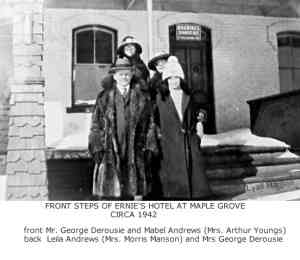 Sunday, July 10, 1932, was a very warm day. A group of probably 20 to 30 locals had gathered at the Wharf for sunning and swimming. Included was my older brother, Jim, aged 11; my younger brother, Donald, aged 6; and me, aged 8. Toward the end of the afternoon, Jim swam the width of the canal, across to the towpath, with the aid of an inflated automobile inner tube. Donald and I were sitting on the ledge with our feet dangling in the deep water. When Jim reached the towpath and pulled himself ashore, he called across that the inner tube had sprung a leak and he couldn’t make it back on his own. He asked me to go home for the key to our grandfather’s rowboat, which was tethered to a dock in the village, and to bring the boat down to his rescue. At this point, all of the other swimmers had departed for the day and the three of us were the only ones remaining at the Wharf.
Sunday, July 10, 1932, was a very warm day. A group of probably 20 to 30 locals had gathered at the Wharf for sunning and swimming. Included was my older brother, Jim, aged 11; my younger brother, Donald, aged 6; and me, aged 8. Toward the end of the afternoon, Jim swam the width of the canal, across to the towpath, with the aid of an inflated automobile inner tube. Donald and I were sitting on the ledge with our feet dangling in the deep water. When Jim reached the towpath and pulled himself ashore, he called across that the inner tube had sprung a leak and he couldn’t make it back on his own. He asked me to go home for the key to our grandfather’s rowboat, which was tethered to a dock in the village, and to bring the boat down to his rescue. At this point, all of the other swimmers had departed for the day and the three of us were the only ones remaining at the Wharf.
I climbed from the ledge to the upper level and was dressing when I heard a splash. Simultaneously, Jim called across that Donald had fallen from the ledge, in expectation of reaching out and pulling him back to shore. However, Donald was thrashing about in the water and pushing himself farther out. I could not reach him. Although I had never been in deep water, while still holding the rock ledge, I lowered myself into the water and again reached out and held out my leg, hoping he could grab it. by this time, Donald was under water with only his flailing hands above water and they, too, disappeared beneath the surface. I climbed back to the ledge and watched, mesmerized, as he slowly sank and drifted downstream, carried by the undercurrent, until he disappeared from sight.
I climbed back to the upper level and it was only then that I realized Jim had been calling for help. It was at this point that George Derousie appeared on the scene in response to Jim’s distress calls. He was not a young man, being 58 years of age at the time. He was rather small in stature but of a wiry build and in relatively good physical condition. He was dressed in his Sunday best, wearing a hat and a navy blue suit and had been out for a Sunday stroll, when he heard Jim calling.
While shedding his hat, suit coat, vest and shoes, he asked me to point out where I had last seen Donald, and I did so. Without hesitation, he dived into the deep water and he seemed to be submerged for a lifetime. I was filled with dread when he eventually returned to the surface empty handed.
He climbed out of the water to the ledge and back up to the upper level. Again, he asked me where I had last seen Donald drifting downstream, when he disappeared. George then dived in a second time, further downstream. By this time, his daughter, Reta, had appeared on the scene to help.
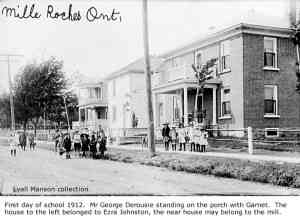 After what seemed like an interminably long time, during which I had visions of two victims rather than one, George returned to the surface, considerably downstream, and this time he had Donald with him. Rita and I ran around to the shallow area and waded out to meet her father and he brought Donald in. We took Donald from him and carried him to the upper level, where we lay him down on his stomach to pump the water form him. Despite the fact that he had been under water from five to ten minutes, he came around very quickly. He had given up a considerable amount of water but, when he began to cry, we knew he would be alright.
After what seemed like an interminably long time, during which I had visions of two victims rather than one, George returned to the surface, considerably downstream, and this time he had Donald with him. Rita and I ran around to the shallow area and waded out to meet her father and he brought Donald in. We took Donald from him and carried him to the upper level, where we lay him down on his stomach to pump the water form him. Despite the fact that he had been under water from five to ten minutes, he came around very quickly. He had given up a considerable amount of water but, when he began to cry, we knew he would be alright.
By this time, several people had gathered to help and someone obtained a rowboat to rescue Jim from the two-path across the canal.
If it had not been for Jim’s cries for help and George Derousie prompt and courageous response, putting his own life on the line without thought, not once but twice, this would have been a tragedy. Even a couple of minutes later would have been too late.
When walking home, Donald asked that we not report the incident to our parents, fearing he might not be allowed to swim at the Wharf again, without supervision. Just the opposite occurred.
On hearing the news of the near tragedy, my mother gathered everyone together and as a family unit, we visited the Derousie home to thank George Derousie for his heroics.
My mother, being a Registered Nurse, had the presence of mind, in order to prevent the development of a fear of water (aquaphobia) from his incident insisted that we immediately return to the Wharf for a swim. This apparently had the desired effect since we all subsequently became experienced swimmers.
George Derousie died in 1963, at age 89, after a long and productive life. He took to the grave with him unbounded respect.
Donald died in 2004, at age 78, after an accomplished career in mechanical and architectural drafting. George Derousie salvaged 72 of those years for him.
Jim died in 2006, at age 78, after a long technical career in the pulp and paper industry, and as an international tour organizer. He can also take credit for Donald’s bonus years for having the presence of mind to summon emergency help.
Very few people were aware of this near tragedy. It was not reported in the news and did not appear to travel very far, locally, by word of month. George Derousie was never officially recognized for his heroism as he would be if the incident occurred today
As the last remaining player in that drama of July 10, 1932, I feel compelled to record that act of heroism on the part of George Derousie before it is too late and totally forgotten. The man deserve more. He at least deserves this.
L. T. Welch, July 10, 2007, Age 83
THE FORMATION OF “OLD MILLE ROCHES”
While sorting through some of the papers in the Fran Laflamme collection, Alan Rafuse made a most interesting discovery, one which helped him to understand the creation of that part of Mille Roches known as “Old Mille Roches”. Many will remember this location at the eastern end of Sheek’s Island, and many will remember those who lived in this area, across the swing bridge from the mainland.
The following information is from the COMMITTEE OF PETITION OF THE INHABITANTS OF MILLE ROCHES, dated Mille Roches, March 31, 1836; and the REPORT OF THE PETITION OF THE PROPRIETORS OF THE VILLAGE OF MILLE ROCHES IN THE TOWNSHIP OF CORNWALL, TO THE HON. THE COMMONS HOUSE OF ASSEMBLY, 1836. COMMITTEE ON PETITION OF THE INHABITANTS OF MILLE ROCHES
The Memorial of the Proprietors of the Village of Mille Roches, in the Townships of Cornwall and Eastern District. MOST HUMBLY SWEARETH: That the said Village is situated upwards of five miles above the Town of Cornwall, on a branch of the River Saint Lawrence, being a stream adequate to every mechanical work and manufactory requiring water privileges, which happiness of situation was not enjoyed by any place, within the distance of fifty miles, either up or down the river. That, therefore, said Village was rapidly improving, an extensive Grist Mill, Marble Factory, and Marble Saw-Mill, Carding Works, and Clothiers Works having been erected, and many artisans and mechanics settled, and preparing to build and settle therein.
That the manner in which the canal is now laid out has destroyed all these prospects, the line of which strikes from the river above the Village, intersecting the main road, and then runs South East until it again intersects the road and goes by the river a considerable way below the Village, and the Commissioners have, in consequence, altered the said high-way which formed its main street and led from Montreal to Toronto, running the same still east of the canal, thereby completely isolating the village and entirely cutting off all communication with the adjoining country, except by a small tunnel or current totally inadequate for the transaction of business, and turning aside the concourse of travelers; and which now is, and every winter will be stopped with ice by the rising of the river throwing back water therein; as the annexed map more fully explains.
That by these destructive changes all lucrative intercourse is absolutely lost. and your memorialists, instead of the pleasing hope of trade and commerce, are now obliged to look for other homes, many of whom after residing there the best portion of their existence. That in addition to the above calamitous state of their affairs, a few of your memorialists own lands contiguous to the marble quarry in the vicinity of the village, now excavating to build the Locks, where Mr. Mills the Engineer laid out a few acres for the use of the labourers, entirely insufficient for the purpose; there being upwards of forty houses, or shanties, now erected round the quarry – and the labourers have now used a large quantity of fuel which grew on land exterior and far beyond the area allotted them by the Engineer, and as the poor men are unable and unwilling to pay therefor coercion would lead to evil consequences and only tend to a bill of expenses on the district – thus the owners are deprived of the fuel necessary for their own houses, without hopes of redress. That your Memorialists would by no means trouble your Honourable House with their grievances only after submitting them to the Commissioners, praying for remuneration, they declined acting on the case, by arbitration or otherwise on the plea that the power vested in them gave them no authority, thereby throwing your Memorialists on the decision of the Legislature. Nevertheless, your Memorialists conceive that the act in reference to the Village is full and explicit – therefore they have no desire to trouble your Honourable House with any amendment therein, but merely that you will be pleased to desire the Commissioners, forthwith, to act up to its spirit, as well as its letter, and further to extend its benefit towards the payment by them of the wood now used, or which may be used by the labourers in said Quarry, extra to the quantity allotted by the Engineer, which has long since been used in erecting their shanties and for fuel.
That these grievances are by no means exaggerated, as the premises, which, only three years since, would let from thirty to fifty pounds yearly, could not now be rented for any sum, except to labourers on the canal for some trivial pittance – a class of tenancy not desirable to occupy valuable buildings. Thus your Memorialists humbly lay their case before your Honourable House, confiding in your clemency and in full confidence that you will be graciously pleased to desire the Commissioners to effectually enter into the merits thereof the act with as much promptitude as its nature admits, and their distressed and uncertain conditions crave, for which, as in duty bound, they shall every pray.
Signed by George Robertson, and thirty-four others.
REPORT OF THE PETITION OF THE PROPRIETERS OF THE VILLAGE OF MILLE ROCHES
The Select Committee to which was referred the petition of George Robertson, Sewell Culter, Elijah Burpee, Thomas H. Maxwell, Nelson Stevens, Wm. J. Hamilton, and twenty-nine others, proprietors of the Village of Mille Roches, on the River Saint Lawrence, have, in obedience to the order of the House, enquired into the allegations and complaints of the petitioners, examined witnesses and agreed to the following report.
The petitioners set forth that Mille Roches is situated about five miles above Cornwall, on a branch of the Saint Lawrence, in a situation conferring extensive water power, which the inhabitants had improved; that at the time the Saint Lawrence Canal was laid out, the Village was in a prosperous condition, and that the main high-way, or post-road, between Montreal and Toronto passed through it, forming its main street; that the canal has intersected the post road both below and above Mille Roches, and the Commissioners have altered the highway and taken it to the other side of the canal at a distance from the Village, thereby isolating the Village and entirely cutting off all communication by land with the adjacent country, except by a small culvert, which is stopped by ice in the winter and very inefficient as a carriage road in summer; that the trade and intercourse of the inhabitants are greatly impeded; that the fuel in the neighbourhood is burnt up by the labourers on the canal; that the Commissioners decline or refuse to build those bridges which would restore Mille Roches to its accustomed prosperity, although premises which three years ago would have rented at from thirty to fifty pounds yearly, could only be now let to the canal labourers at a trifling rent.
Your Committee have examined Messrs. Shaver and Norton, two of the Saint Lawrence Canal Commissioners, who state, that besides the culverts the Board contemplate the erection of scows, to be drawn across the canal; that bridges were not built because it was considered by the Board that their erection would be very injurious to the navigation; and that no compensation was ordered to be paid to the inhabitants of Mille Roches for damages, although injury had been done them by the loss of the post road and the traffic of their Village, for which, in the opinion of Messrs. Shaver and Norton, “they ought to receive a fair compensation by arbitration as stated by the act.”
These Commissioners think it would be better that the petitioners should be paid their damages, and that no bridges should be erected, it being the opinion of the Canal Board that the erection of the bridges that would be required under the act would prove ruinous to the navigation; as also, that there is reason to fear that the culvert will not fully answer, and that the people should be remunerated whether the scows and culvert fail or succeed.
Mr. McLean, Member for Cornwall, considers that the former road should be restored by bridges as the only effectual means of affording full relief to memorialists who have very strong claims for relief. Your Committee are of opinion that it was the duty of the Commissioners to hasten to compensate the proprietors of property in Mille Roches, whose claim to relief is well established. On a reference to the Canal Act there appears to be ample powers conferred on them for that purpose. Your Committee respectfully submit for the consideration of the House a resolution framed in accordance with the views they entertain, as stated in this report. D.A. McDonell, Chairman.
DAILY STANDARD FREEHOLDER
Cornwall, Saturday, August 4, 1956
House to Remember
The Brooks House at old Mille Roches 100 years ago was the home of fine furniture and internationally known for its sturdy construction and comfortable design. Isreal Brooks began furniture making during the late 1700’s in a shed beside the house in old Mille Roches on Sheek Island which he had bought from a Mr. Harriman of the United States. The Brooks’ workmanship continued for two geneations. Loren Brooks, still living at Woodlands, did not continue the tradition. Photo shows four year old Carol Markell sitting in a miniature model of the famous Brooks rocking chairs. Carol is the daughter of Mr. and Mrs. Lawrence W. Markell, now living in the Brooks House.
Former Furniture Making Centre of Area, Brooks House is Doomed by Ray Dextras (staff Reporter)
The Brooks House, at one time the furniture making centre of this area, constitutes an important chapter in the early history of the Three United Counties. The 160 year old house is situated on Sheek Island in “old” Mille Roches across the canal from the present townsite.
To get to it, you cross the swinging bridge and turn right on the road to Ault Park. Instead of continuing straight, you turn left down the road along the gully of the old power house, and follow a narrow winding, shaded drive through old Mille Roches, then down a steep hill to the Brooks House.
Surrounded on the west side by trees, a wheat field spreading out to the east, a spacious lawn and the canal dyke to the north it is an ideal location for the artistic temperament. And that it was, for the Brooks were artists in furniture making. Their work is now in many home across the countryside, in bigger centres in Ontario, and in the United States.
FAMOUS NAMES
Some famous names have visited the house, including that of Lewis Addison Ault born in 1851 at Moulinette and founder of the Ault and Wiborg Ink Company in Cincinnati and after whom is named Ault Park on Sheek Island; he donated the land to the people of the area.
He used to visit the Brooks House every summer, come in for tea, and see what new furniture had been made and how it was wearing, (originally, the house contained all Brooks made furniture). He was entertained in the gracious living room, seated in a Brooks made chair and listening to an Emerson baby grand piano, brought all the way from Boston over 100 years ago. (Even today the furniture, as well as the piano are in excellent condition.
The distinguished visitor is given a long mention in J. G. Harkness “A History of Stormont, Dundas and Glengarry.” Here, in part:…”Mr. L. A. Ault went to Cincinnati as a young man and founded Ault and Wiborg Ink Company, one of the largest of such companies in the United States. He was also President of the Park Board of Cincinnati for nineteen years, developing its many boulevards and in 1928, he and his wife gave 143 acres to the city for a Park. The selection of the location is “Ault Park”, as it is called, was a very happy one as it is on a high site commanding a panoramic view for many miles. His beautiful home over looking the Ohio River was occupied by King Albert of Belgium and his Queen during their visit to Cincinnati when Mr.. Ault was decorated by the King for the valuable services he rendered to the Allies 1914-1918…”
ANCIENT CLOCK
The grandfather clock is a curiosity. Over 100 years old, all the cogs and wheels but one are made of wood. Loren P. Brooks, 81, last generation of the Brooks family, recalls that whenever the clock broke down, a Mille Roches man called “Bland Raymond” would the clock’s mechanism apart, puts the parts in a pail and bring them home to repair the damages, after which he would take them back and reassemble the parts at the Brooks house.
Mr. Brooks who was born in the Brooks House in 1875, also recalls that people from all over the country would come to the house to buy the strongly made and beautiful furniture. A feature of Brooks workmanship is the style of kitchen rocking chairs, an article which most everybody bought from the Brooks. They are extremely comfortable, this reporter having tried one himself. The peculiarity of the design is the big curved seat, sloping up the back of the chair, and, together with the curving spokes of the back, makes for a comfortable pasture correct sitting position, strangely adaptable to any adult size. The chairs were so popular that baby chairs to match had to be made.
One Brooks chair oddity is one in the Kezer House at Mille Roches, (the Kezar House was the subject of an article in this same series), the chair having been made entirely with a carving knife!! Its’ apparent, too, even after being sanded and painted, the uneven wavy edges and crooked spokes looking like what might be in a frontier cabin.
MANY ARTICLES
 Of course, the Brooks did all sorts of woodworking, such as bureaus, tables, bedsteads, shelves, butter churns, and even coffins, some of which are still in the workshop beside the house.
Of course, the Brooks did all sorts of woodworking, such as bureaus, tables, bedsteads, shelves, butter churns, and even coffins, some of which are still in the workshop beside the house.
The wood was obtained from the Robertson’s sawmill nearby up along the riverbank. The Robertson sawmill received its power from a small rapids section on the north side of the island before the dam for the canal was built. Connections between the mainland and the island was made by a tunnel running under the canal.
Note: Feb.2009, a further two paragraphs with dates aren’t legible at this time but the old newspaper clippings and the chair can be viewed at the museum.
From the “My Hometown” section of the magazine Our Canada
The Village that Couldn’t Swim
by Edna Smith (Stansel)
When Mile Roches, Ont. was flooded to open up a shipping link between the Great Lakes and the Atlantic Ocean, it was time to move!
I was born in the lovely village of Mille Roches, Ont. in 1926. It was a wonderful place to grow up. But my town is gone now. In my mind’s eye, I can still see the layout of the village and all of its sights and sounds. I can smell the sawdust on the floor of the meat market on the corner, and I can still hear the clamour of the paper mill as I made my way to school.
Our little village had only 900 people, but we always found things to do. In summer we learned to swim in the St. Lawrence River, right across from where we lived, and in winter we skated on it. During warmer weather, the owners of the local arena put in a wooden floor, and every weekend there was dancing.
Back then, a tow path separated the canal from the river, and the Canada Steamship Lines ships sailed up and down with their cargoes. There was a swing bridge over the canal. We knew the bridge workers, and they often let us ride on it when they were opening the bridge to let the ships through.
The rapids, ten miles upriver, were a gathering place for tourists. The Rapids prince, a boat something like the ones that ply the waters of the Mississippi, would shoot the rapids every Sunday, and that was a lovely sight to see.
Not far from our house was Frying Pan Island, where people from the surrounding district had cottages. When we were in our teens, six of us girls, school chums, rented a cottage there for five years in a row. It was so much fun! We’d stay from June until September. We had summer jobs in Cornwall and got rides back and forth from a neighbour who had a car.
In the late 1950s, nine villages, including mine, were flooded to create the St. Lawrence Seaway. The town folk were as busy as bees moving the homes that could be salvaged to the new town sites, Long Sault and Ingleside, about seven miles away. The wooden homes were moved on trailers, but ours was brick, and had to be knocked down. Even the cemeteries were moved!
The provincial paper mill, the main source of jobs for the village, was dismantled and relocated to Thorold, Ont. Many of the families moved there to keep their jobs. My dad was, the superintendent of the mill for 25 years. A few years after my husband, Wilfred, and I moved to B.C., we became active members of a seniors’ centre. There, seniors could get together with kids from the nearby Cougar Canyon school and tell them what life was like when we were young. I told the story of the St. Lawrence Seaway to some bright Grade 6 students and showed them my photo album. The children posted what they learned on the Internet so the others could see.
British Columbia is our home now, but when I go “back east”, it still feels comfortable. In a way, I’ve been blessed with two homes!
Some information on this page is courtesy of the Ghost Town Pix website by Jeri Danyleyko. For more great historical information on this village and many others across Canada, be sure to check out http://www.ghosttownpix.com/lostvillages/millroch.html.

